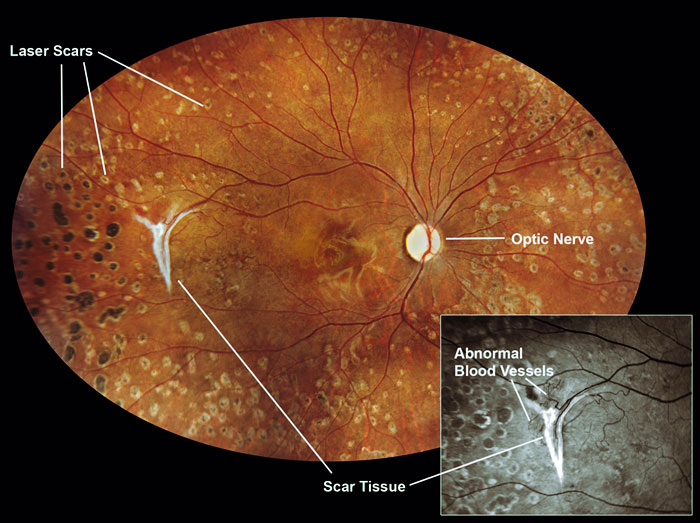
July, 2009
Snapshot
Lupus and Laser Treatment
Abnormal blood vessels growing in the retina

This color photograph, taken through a person's pupil, shows the back, inner surface of the right eye. This person has lupus, a chronic disease in which the immune system attacks healthy tissues and organs. The immune system also deposits antibodies and other immune compounds in blood vessels, leading to inflammation and blockage.
Blocked vessels prevent blood and oxygen from reaching the retina, the light-sensitive tissue in the back of the eye. The lack of oxygen causes the eye to produce molecules involved in inflammation, including a protein called vascular endothelial growth factor (VEGF). VEGF stimulates the growth of new, fragile blood vessels in the retina that can bleed, causing vision loss.
The red-colored tissue in this photo is the retina, and the yellow circle is the optic nerve, which leads to the brain. The tiny blood vessels around the v-shaped scar are caused by lupus (detailed in the black and white inset photograph).
Doctors used a combination of strategies to stop the abnormal blood vessel growth. First, this person received laser treatment, which is indicated by the yellow and brown scars. Next, the person received an eye injection of a drug that blocks the production of VEGF.
After these treatments, the new blood vessel growth stopped, leaving behind the v-shaped, scar tissue. This person's central vision remained normal at 20/20.
Image courtesy of NEI staff clinician H. Nida Sen, M.D., M.H.Sc., clinical fellow Chloe Gottlieb, M.D., F.R.C.S.C., and ophthalmic imaging specialist Michael Bono, B.A., C.R.A., C.O.T.

